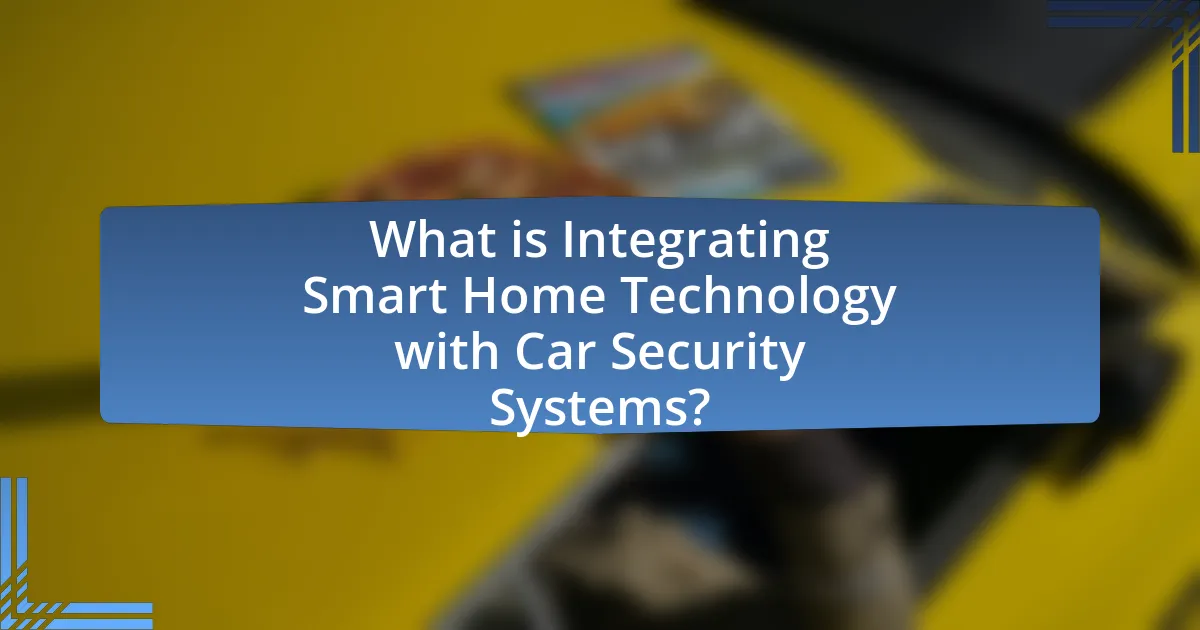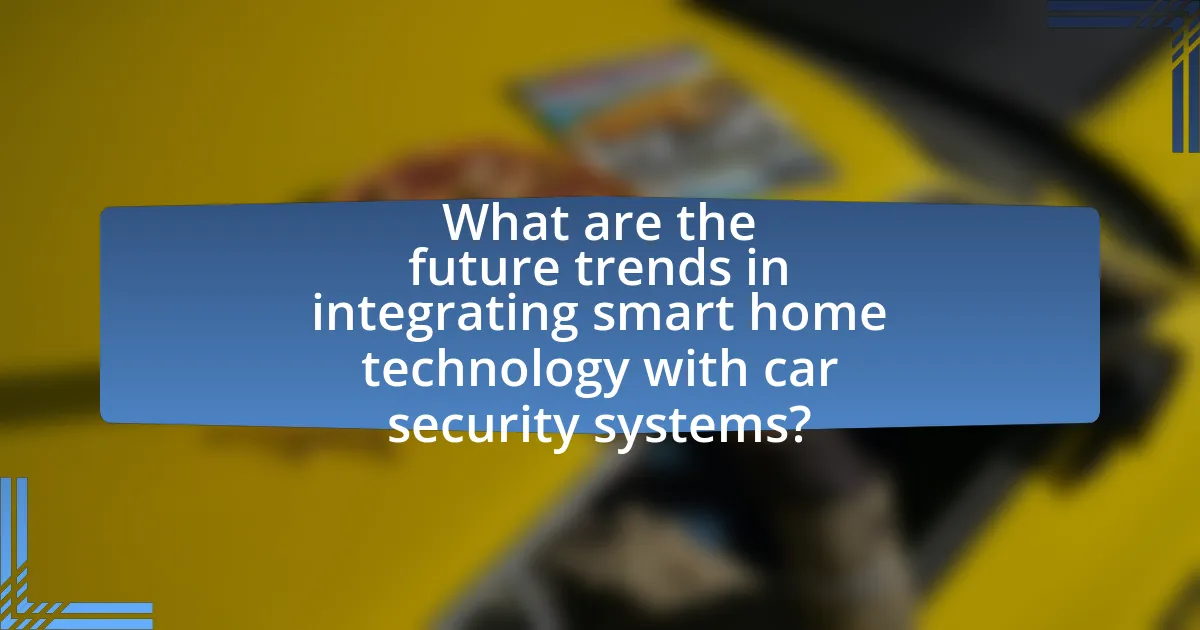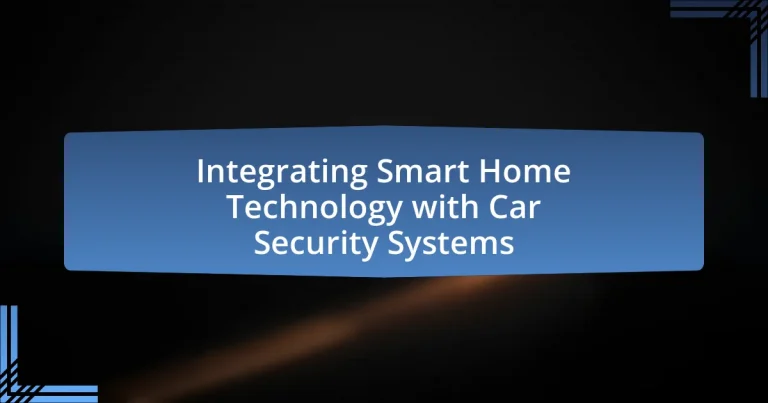Integrating smart home technology with car security systems refers to the connection between home automation devices and vehicle security features, enhancing safety and convenience for users. This integration allows for remote monitoring and control of vehicles through smart home platforms, enabling functionalities such as locking doors, tracking location, and receiving alerts about unauthorized access. Key benefits include improved security, streamlined user experience, and potential cost savings through reduced insurance premiums. However, challenges such as compatibility issues, security vulnerabilities, and user privacy concerns must be addressed to ensure effective integration. Future trends indicate advancements in connectivity, automation, and artificial intelligence, which will further enhance the capabilities of these integrated systems.

What is Integrating Smart Home Technology with Car Security Systems?
Integrating smart home technology with car security systems involves the seamless connection of home automation devices with vehicle security features to enhance safety and convenience. This integration allows users to monitor and control their vehicles remotely through smart home platforms, enabling functionalities such as locking/unlocking doors, tracking vehicle location, and receiving alerts about unauthorized access. For instance, systems like Amazon Alexa or Google Assistant can be programmed to interact with both home security and car systems, providing a unified interface for users. This approach not only improves security but also streamlines user experience by consolidating control into a single ecosystem.
How does the integration of smart home technology enhance car security systems?
The integration of smart home technology enhances car security systems by enabling remote monitoring and control of vehicle security features through smart devices. This connectivity allows users to receive real-time alerts about unauthorized access or suspicious activity, enhancing overall security. For instance, systems can be programmed to lock or unlock doors, activate alarms, or track the vehicle’s location via smartphone applications. Research indicates that homes equipped with smart technology experience a 20% reduction in burglary rates, suggesting that similar principles applied to vehicles can significantly deter theft and enhance safety.
What specific smart home technologies are commonly integrated with car security systems?
Commonly integrated smart home technologies with car security systems include smart locks, security cameras, and home automation hubs. Smart locks enable remote locking and unlocking of vehicle doors, enhancing security and convenience. Security cameras provide real-time monitoring and alerts for suspicious activities around the vehicle, often accessible via mobile apps. Home automation hubs, such as Amazon Echo or Google Nest, facilitate seamless communication between the car security system and other smart devices, allowing for coordinated security measures. These integrations enhance overall safety and provide users with greater control over their vehicle security.
How do these technologies communicate with each other?
Smart home technology and car security systems communicate with each other primarily through wireless protocols such as Wi-Fi, Bluetooth, and Zigbee. These protocols enable devices to exchange data and commands, allowing for seamless integration and control. For instance, a smart home hub can send alerts to a car security system when a security breach is detected at home, and the car can respond by locking its doors or activating its alarm. This interoperability is often facilitated by APIs (Application Programming Interfaces) that allow different systems to share information and commands effectively, ensuring that both smart home devices and car security systems work in harmony to enhance overall security and convenience.
What are the key benefits of integrating smart home technology with car security systems?
Integrating smart home technology with car security systems enhances overall security and convenience. This integration allows for real-time monitoring and control of both home and vehicle security features through a single interface, improving user experience. For instance, users can receive alerts on their smartphones if their car is tampered with while at home, enabling immediate action. Additionally, features like remote locking and unlocking of the vehicle can be managed alongside home security systems, streamlining user interactions. Studies indicate that homes equipped with smart technology experience a 20% reduction in burglary rates, demonstrating the effectiveness of integrated security solutions.
How does this integration improve user convenience and safety?
The integration of smart home technology with car security systems significantly enhances user convenience and safety by enabling seamless control and monitoring of both environments from a single interface. This integration allows users to remotely lock or unlock their vehicles, receive real-time alerts about security breaches, and monitor their car’s location through smart home devices. For instance, a study by the Consumer Technology Association found that 70% of smart home device users reported increased peace of mind regarding their home and vehicle security. Additionally, features like geofencing can alert users if their vehicle strays beyond a designated area, further enhancing safety.
What cost savings can be achieved through this integration?
Cost savings achieved through the integration of smart home technology with car security systems include reduced insurance premiums and lower theft-related losses. Insurance companies often provide discounts for vehicles equipped with advanced security features, which can lead to savings of up to 20% on premiums. Additionally, the integration can minimize the financial impact of theft by enabling real-time monitoring and alerts, potentially reducing the frequency and severity of theft incidents. This proactive approach can save owners thousands of dollars in replacement costs and related expenses.

What challenges exist in integrating smart home technology with car security systems?
Integrating smart home technology with car security systems faces several challenges, primarily related to compatibility, security vulnerabilities, and user privacy. Compatibility issues arise because different manufacturers often use proprietary protocols, making it difficult for devices to communicate effectively. Security vulnerabilities are a significant concern, as connecting vehicles to home networks can expose them to cyberattacks; for instance, a 2020 study by the University of California highlighted that over 80% of connected vehicles have potential security flaws. User privacy is also at risk, as data sharing between smart home devices and vehicles can lead to unauthorized access to personal information. These challenges hinder seamless integration and raise concerns among consumers regarding the safety and reliability of such systems.
What security concerns arise from this integration?
The integration of smart home technology with car security systems raises significant security concerns, primarily related to unauthorized access and data privacy. Unauthorized access can occur when hackers exploit vulnerabilities in the interconnected systems, potentially allowing them to control both the home and vehicle remotely. For instance, a study by the University of California, Berkeley, highlighted that smart home devices often lack robust security measures, making them susceptible to cyberattacks. Additionally, data privacy issues arise as these systems collect and share sensitive information, such as location and personal habits, which can be intercepted or misused by malicious actors. The combination of these factors creates a heightened risk for users, emphasizing the need for enhanced security protocols in such integrations.
How can vulnerabilities in smart home technology affect car security?
Vulnerabilities in smart home technology can significantly compromise car security by providing unauthorized access to vehicle systems. For instance, if a smart home device is hacked, attackers can exploit the interconnectedness of smart devices to gain control over the car’s keyless entry system or remote start features. A study by the University of California, Berkeley, highlighted that over 50% of smart home devices have security flaws that could be leveraged by cybercriminals to infiltrate other connected systems, including vehicles. This interconnected vulnerability underscores the importance of robust security measures in both smart home and automotive technologies to prevent unauthorized access and potential theft.
What measures can be taken to mitigate these risks?
To mitigate risks associated with integrating smart home technology with car security systems, implementing robust cybersecurity measures is essential. This includes using strong encryption protocols for data transmission between devices, ensuring that both smart home and car systems are regularly updated to patch vulnerabilities, and employing multi-factor authentication to prevent unauthorized access. According to a 2021 study by the Cybersecurity & Infrastructure Security Agency, 85% of breaches exploit known vulnerabilities, highlighting the importance of timely updates and security measures. Additionally, conducting regular security audits can help identify and address potential weaknesses in the integrated systems.
How does the integration impact user experience?
The integration of smart home technology with car security systems significantly enhances user experience by providing seamless control and monitoring capabilities. Users benefit from centralized management, allowing them to access and manage both home and vehicle security through a single interface, often via mobile applications. This integration leads to increased convenience, as users can receive real-time alerts and notifications about their vehicle’s status while at home, and vice versa. For instance, a study by the Consumer Technology Association found that 70% of smart home device users reported improved peace of mind due to enhanced security features, illustrating the positive impact on user experience.
What features enhance the user interface for managing both systems?
The features that enhance the user interface for managing both smart home technology and car security systems include centralized control dashboards, real-time notifications, and seamless integration capabilities. Centralized control dashboards allow users to manage both systems from a single interface, improving accessibility and user experience. Real-time notifications provide immediate alerts regarding security breaches or system status changes, ensuring users remain informed. Seamless integration capabilities enable devices from different manufacturers to communicate effectively, enhancing functionality and user convenience. These features collectively streamline management and improve the overall user experience in integrating smart home technology with car security systems.
How does user feedback influence the development of integrated systems?
User feedback significantly influences the development of integrated systems by providing insights into user needs and preferences, which guide design and functionality improvements. For instance, when users report issues or suggest features, developers can prioritize these inputs to enhance system usability and performance. A study by Nielsen Norman Group indicates that user-centered design, which incorporates user feedback, leads to a 50% increase in user satisfaction and engagement. This demonstrates that integrating user feedback not only aligns the system with user expectations but also fosters innovation and efficiency in the development process.

What are the future trends in integrating smart home technology with car security systems?
Future trends in integrating smart home technology with car security systems include enhanced connectivity, advanced automation, and improved data analytics. Enhanced connectivity will allow vehicles to communicate seamlessly with smart home devices, enabling features such as remote locking and unlocking of doors through home automation systems. Advanced automation will facilitate scenarios where the car can automatically adjust home settings, like turning on lights or adjusting thermostats when the driver approaches. Improved data analytics will leverage machine learning to predict security threats and optimize responses, such as alerting homeowners of suspicious activity around their vehicle. These trends are supported by the increasing adoption of IoT devices, which is projected to reach 75 billion globally by 2025, indicating a robust market for integrated solutions.
How is artificial intelligence shaping the future of this integration?
Artificial intelligence is shaping the future of integrating smart home technology with car security systems by enabling seamless communication and enhanced security features. AI algorithms analyze data from both smart home devices and vehicle systems to create a unified security network, allowing for real-time monitoring and automated responses to potential threats. For instance, AI can detect unusual patterns in user behavior, such as unauthorized access attempts, and trigger alerts or lock down systems automatically. This integration is supported by advancements in machine learning and IoT connectivity, which facilitate the exchange of information between devices, ensuring that both home and vehicle security are synchronized and more effective.
What role does machine learning play in enhancing security features?
Machine learning significantly enhances security features by enabling systems to detect and respond to threats in real-time. It analyzes vast amounts of data from various sources, identifying patterns and anomalies that indicate potential security breaches. For instance, machine learning algorithms can improve intrusion detection systems by learning from historical attack data, allowing them to recognize new threats more effectively. Research shows that systems utilizing machine learning can reduce false positives by up to 50%, thereby increasing the reliability of security alerts. This capability is crucial in the context of integrating smart home technology with car security systems, where timely and accurate threat detection is essential for protecting both home and vehicle.
How might future advancements in technology further improve integration?
Future advancements in technology will enhance integration between smart home technology and car security systems through improved interoperability and real-time data sharing. For instance, the development of standardized communication protocols, such as Vehicle-to-Everything (V2X) technology, will enable seamless interaction between vehicles and smart home devices, allowing for features like remote locking, monitoring, and alerts. Additionally, advancements in artificial intelligence and machine learning will facilitate predictive analytics, enabling systems to anticipate security threats and respond proactively. Research indicates that the integration of IoT devices can reduce response times to security breaches by up to 50%, demonstrating the potential for enhanced safety and efficiency in connected environments.
What practical tips can users follow for effective integration?
To achieve effective integration of smart home technology with car security systems, users should ensure compatibility between devices. This involves selecting smart home products that support common communication protocols like Z-Wave or Zigbee, which facilitate seamless interaction. Additionally, users should utilize a centralized hub to manage both smart home and car security devices, allowing for streamlined control and automation. Research indicates that systems integrated through a hub can enhance security and convenience, as evidenced by a study from the Consumer Technology Association, which found that 70% of users reported improved home security when using integrated systems. Regularly updating software and firmware for all devices is also crucial, as it ensures optimal performance and security against vulnerabilities.
How can users ensure compatibility between smart home devices and car security systems?
Users can ensure compatibility between smart home devices and car security systems by verifying that both systems support common communication protocols, such as Z-Wave, Zigbee, or Wi-Fi. Compatibility is often determined by the ability of devices to communicate over these standardized protocols, which facilitate integration. For instance, many smart home hubs are designed to connect with various car security systems that also utilize these protocols, allowing for seamless interaction and control. Additionally, users should consult product specifications and compatibility lists provided by manufacturers to confirm that their devices can work together effectively.
What best practices should users adopt for maintaining security in integrated systems?
Users should adopt strong password management, regular software updates, and network security measures to maintain security in integrated systems. Strong password management involves using complex, unique passwords for each device and enabling two-factor authentication where available, which significantly reduces the risk of unauthorized access. Regular software updates are crucial as they often include security patches that protect against newly discovered vulnerabilities; for instance, a 2021 report by Cybersecurity Ventures indicated that 60% of data breaches are linked to unpatched software. Additionally, implementing network security measures, such as using a secure Wi-Fi network with encryption and a firewall, helps safeguard integrated systems from external threats. These practices collectively enhance the security posture of integrated systems, ensuring better protection against potential cyber threats.

